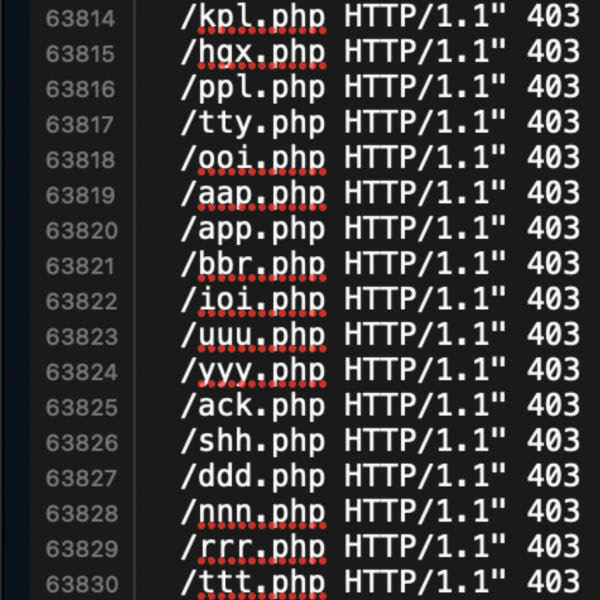I’ve been online since 1999. So 25+ years of finding and dealing with a wide variety of web hosts. While painful at times, this experience enables me to get out there and find better web hosting at the drop of a hat. It’s been a while since I’ve written about my web-hosting experiences, so this post is to share a recent foray into finding a solid managed-VPS solution in the year 2025. Shortcut: Not interested in the diatribe? Jump ahead […] Continue reading »

Good news! The 8G Firewall is updated to version 1.4. This latest update resolves numerous false positives and bugs that have been reported since version 1.3, when 8G was taken out of beta and officially launched last year. Continue reading »
Been getting hit with massive attacks on all sites. Very large VPN/proxy network. Relentless requests 24/7, thousands of requests every minute, just non-stop attacks. All URL requests targeting rogue PHP files. The attacks were weighing on precious server resources. Server held up fine but this nonsense needed to stop. So I wrote a tight little addon for my 8G Firewall. Blocks the entire attack with just a few clicks.. Continue reading »

I’ve been working on developing the 8G Firewall. Digging through log files and crunching the data, the big new trend I’m noticing is heavy scanning for easy targets, low hanging fruit. Bad actors are looking for any little hidden files stashed on your server. Mostly PHP files, also ZIP and RAR files, and other file formats commonly used for compressing and archiving content. Basically, anything that might contain useful information (like login credentials, database backups, email addresses, etc.). Also, 99% […] Continue reading »

This tutorial is for users of my nG Firewall, version 8G or better. It explains how to enable logging for all blocked requests. This is useful for testing, debugging, and keeping an eye on things. Takes only a few minutes to set up, and of course it’s all open source and 100% free for everyone :) Continue reading »

After more than a year of beta testing, 8G Firewall is ready for use on production sites. So you can benefit from the powerful protection provided by the latest evolution of the nG Firewall (aka nG Blacklist). The 8G Firewall offers lightweight, server-level protection against a wide range of malicious requests, bad bots, automated attacks, spam, and many other types of threats and nonsense. 8G is a lightweight (only 17KB) strong firewall that provides site security and peace of mind. […] Continue reading »

The nG Firewall is a carefully crafted set of security rules for Apache and Nginx servers. nG may be applied via your site’s public root .htaccess file, or added via server configuration file. Once added, 8G provides powerful server-level protection against a wide range of malicious requests, bad bots, automated attacks, spam, and many other types of threats and nonsense. It’s a lightweight yet super strong firewall that improves site security and peace of mind. Continue reading »
Recently WordPress sites have been getting hammered with random-string comment spam. The attackers are clever, using random text strings for every vector except the payload, which usually is the URL used for the comment’s Name link. But for these weird comment spams, the apparent payload is the email address. It’s the only part of the comment that’s not made up of random gibberish. Continue reading »

There are many free (and commercial) uptime monitoring services that will alert you if your server goes offline. These services are popular because it’s mission critical to know when your sites are down. The sooner you know about it, the sooner you can scramble to get everything back online. I’ve tried other scripts and services but nothing that met my specific needs: simple, secure, lightweight and blazing fast. So decided roll my own DIY server status monitor and share it […] Continue reading »
In case you hadn’t noticed, I’m on another one of my posting sprees. Going through the past year’s worth of half-written drafts and collected code snippets, and sharing anything that might be useful or interesting. Here is a bit of .htaccess that brings together several redirection techniques into a singular plug-&-play code snippet. Continue reading »

I’ve written many articles about how to redirect requests. Even so, I still get questions about how to set up a simple HTTP request router. As in you want to redirect or route all requests to some file or location. This is useful for building CMSs and scripts that handle traffic. For example, WordPress uses a simple request router when permalinks are enabled. For this tutorial, we’ll set this up using Apache/.htaccess and PHP. Continue reading »

Simple Download Counter is a free WordPress plugin that does exactly what it says: counts the number of times your files are downloaded. SDC is designed for maximum ease of use. The goal is a clean, lightweight “set it and forget it” solution for keeping track of downloads. Simply add your files via the plugin settings and display download links via shortcodes. Simple Download Counter does the rest. Continue reading »
For years, I’ve not used ModSecurity for any of my own sites. Way back when I first tried ModSecurity, there were just too many false positives, so I stayed away from it, opting instead to develop my own fast Apache/.htaccess firewall. But my web host now is telling me that ModSecurity is required on all of their managed VPS plans. Continue reading »
There are numerous ways to redirect requests using Apache’s mod_rewrite and mod_alias. This concise, friendly tutorial explains different ways to redirect a range of IP addresses, either IPv4 or IPv6. Continue reading »

Google has another new thing they are doing, called FLOC (Federated Learning of Cohorts). It’s used to — surprise — track user activity across websites. Opting out ideally is handled by the user, who can customize their browser settings to disable FLOC while surfing around the Web. Beyond configuring your browser to opt-out of FLOC, you can disable it on any website with a single line of code. Continue reading »
Let’s say you have some .htaccess rewrite rules in place using Apache’s mod_rewrite. By default if the rewrite rules are located in the root directory, they will be applied to every subdirectory, as expected. But what if you need to disable the rewrite rules so that they do not affect some specific sub-directory or sub-folder? This super quick tutorial shows the easiest way to do it. Continue reading »








